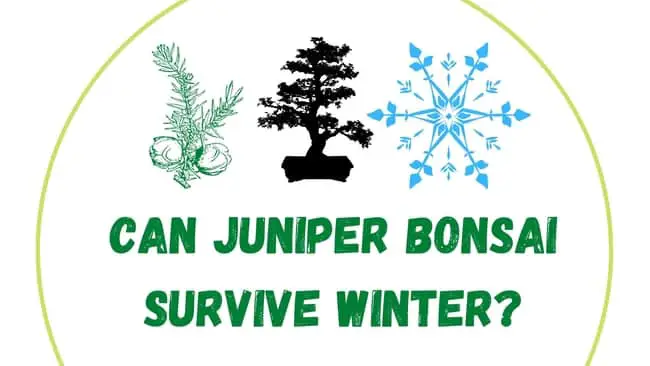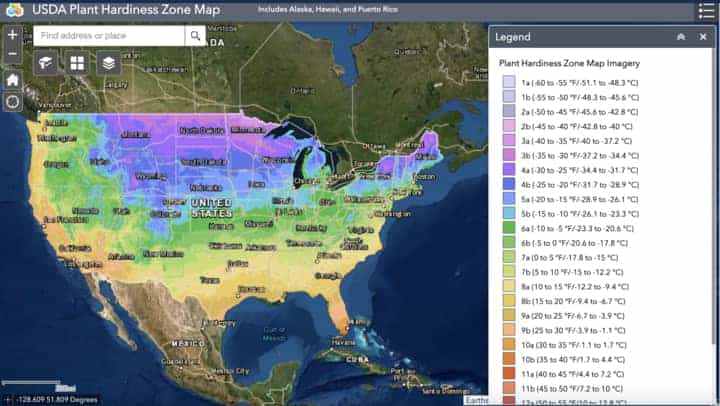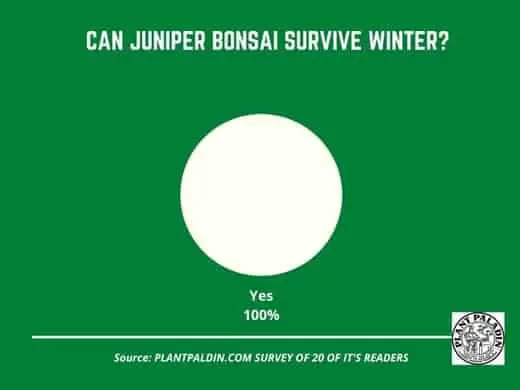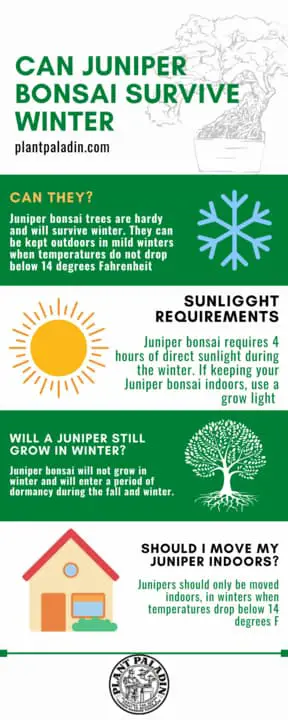This website is supported by its readers. If you click one of my links I may earn a commission. I am also a participant in the Amazon affiliates program and I will also earn a commission from qualified purchases.

Juniper bonsai trees are one of the most popular tree species used in the art of bonsai. These species are incredibly hardy and boast evergreen needle-like leaves year-round. Winter can be very harsh on many bonsai species, so can Juniper bonsai survive winter?
Juniper bonsai trees are hardy and will survive winter. They can be kept outdoors in mild winters when temperatures do not drop below 14 degrees Fahrenheit (-10 degrees Celsius). If temperatures drop below this, you should move Juniper bonsai indoors.
So what are some steps you can take to prevent any severe winter damage to your Juniper bonsai? And should you continue to fertilize your bonsai tree during winter? Keep reading to find out more!
Just a quick heads up, over the past three years of running Plantpaladin, hundreds of people have asked for product recommendations. As such, You can find my favorite indoor bonsai tree here (link takes you to Bonsaiboy), my favorite outdoor bonsai tree (link takes you to Bonsaiboy), or have a look at all the products I recommend here.
Can Juniper bonsai survive winter?
While I am writing this post in the middle of summer, this is the first year that I will experience a winter with my Juniper bonsai.
As such, like a lot of you, I’m already thinking about if I will need to place my Juniper bonsai indoors during winter or if I can leave it outdoors.
To get to the bottom of this, I visited my local botanical gardens, asked a few experts, and even did a quick survey on 10 Plant Paladin readers who own Junipers and asked them can a Juniper bonsai survive winter.
Hopefully, this will give all of you reading this the most comprehensive post on how a Juniper bonsai can survive winter.
To summarize:
Can Juniper bonsai survive winter? – Quick facts
- Most Juniper bonsai trees can be kept outdoors and will survive winters so long as temperatures do not drop below 14 degrees Fahrenheit or -10 degrees celsius.
- Should temperatures drop below this, Juniper should be kept indoors, in a cold spot in your house – bonsai cold frames or garages, however, can work well for this.
- Some Junipers will benefit from some form of winterization in the colder months – mainly late December and January.
- Protect your Juniper then by covering the bonsai topsoil with mulch or cover it with fleeces to protect the tree from ice and dry winds.
- Dry winds and ice can dehydrate your tree and cause dry, brittle branches.
- Water your juniper bonsai about once to twice per week in the winter.
- Fertilizing, however, should be avoided during the winter months and only undertaken during the spring and summer –
- The tree will go through a period of dormancy and not reap any benefits from fertilizer.
- Juniper bonsai trees, however, still require a lot of sunlight during the winter months and so aim for your tree to get at least 4 hours of daylight in the winter.
- If you have moved your Juniper bonsai indoors, use something like a grow light to help it meet its sunlight needs.
- Juniper bonsai trees that have been weakened through insect attack or fungal infection will require more care in winter – such as using more mulch or a thicker fleece to protect your tree from the elements.
Can I leave my Juniper bonsai outdoors in winter?
Most Juniper bonsai trees can be left outdoors during the winter if kept in climates that receive mild winters. Using mulch or covering Juniper with a fleece during these months is advisable and will usually be most of the winterizing a Juniper needs to go through in winter.
In climates below 14 degrees Fahrenheit or -10 degrees Celsius, it is advisable to move your Juniper bonsai tree indoors.
If you leave your tree outdoors during harsh winters, this can cause frostbite and prevent your tree from coming out of dormancy, and in severe cases, cause death.
Can Juniper bonsai survive winter – USDA guideline
If you live in conditions where winters drop below 14 degrees Fahrenheit, then it is not advisable to keep your tree outdoors, and you should immediately move your trees indoors.
That said, you might be a little bit unsure of if where you live falls into that category, and so hopefully, we can use the USDA’s hardiness zones guidelines below as a way of helping us out:

Juniper bonsai trees should not be kept outdoors in USDA hardiness zones 1a to 7b. These zones regularly have temperatures between -60 Fahrenheit to 10 degrees Fahrenheit. In these conditions, move your Juniper indoors.
Can Juniper bonsai survive winter in your state?
So using the USDA hardiness zones guidelines above, is it safe to leave your Juniper bonsai outdoors during winter in your state?
Juniper bonsai trees cannot survive in the winter outdoors in Montana, North Dakota, Minnesota, South Dakota, Wyoming, Nebraska, Iowa, Maine, and parts of New York state. Juniper bonsai trees should be moved indoors in these states during winter.
For a complete list of states, hopefully, the table below can help:
State | Can Juniper bonsai survive winter outdoors |
Montana | No - move indoors |
North Dakota | No - move indoors |
South Dakota | No - move indoors |
Wyoming | No - move indoors |
Minnesota | No - move indoors |
Wisconsin | No - move indoors |
Michigan | No in northern parts of the state, winterize outdoors in the south of the state |
Nebraska | No - move indoors |
Iowa | No - move indoors |
Maine | No - move indoors |
New York | No in northern parts of the state, winterize outdoors in the south of the state |
Washington | No in northern and eastern parts of the state, winterize outdoors in the west of the state |
Oregon | No in northern and eastern parts of the state, winterize outdoors in the east of the state |
California | Yes |
Arizona | Yes |
New Mexico | Yes |
Texas | Yes |
Georgia | Yes |
Arkansas | Yes |
Oklahoma | Yes |
Kansas | No in northern and eastern parts of the state, winterize outdoors in the south of the state |
Colorado | No - move indoors |
Utah | No in northern and eastern parts of the state, winterize outdoors in the south of the state |
Nevada | No in northerns parts of the state, yes in southern parts of the state. |
Idaho | No - move indoors |
Louisiana | Yes |
Florida | Yes |
Alabama | Yes |
Mississippi | Yes |
Kentucky | Yes |
Illinois | No - move indoors |
Virginia | Yes |
West Virginia | Yes |
South Carolina | Yes |
North Carolina | Yes |
Pennsylvania | No in northern parts of the state, yes in southern parts of the state. |
Indiana | Yes |
Louisiana | Yes |
Tennessee | Yes |
Alaska | No - move indoors |
Hawaii | Yes |
Vermont | No |
Delaware | Yes - but winterize outdoors |
Rhode Island | No - move indoors |
Can Juniper bonsai survive winter in your country?
Many of you will be reading this outside of the USA, so I’ve listed the countries below where winter temperatures drop below 14 degrees Fahrenheit.
Juniper bonsai trees will not survive winter if kept outdoors in most states in the USA, Canada, China, Mongolia, Russia, Kazakhstan, Norway, Sweden, Kyrgyzstan, Finland, Austria, and Estonia.
These countries, on average, have very harsh winters.
If your country is not listed, that does not mean you should keep your Juniper bonsai outdoors. Instead, carefully manage and monitor winter temperatures to ensure it does not drop below this.
Most countries’ temperatures will drop below 14 degrees Fahrenheit now and then, so you won’t have to worry about damaging your tree by monitoring this.
How to protect your Juniper bonsai during winter?
So now we know if it is safe to leave your bonsai tree outdoors during winter or not; what are some general care tips you can follow to ensure your Juniper bonsai survives winter.
After all, even if the climate you live in does not drop below 14 degrees Fahrenheit, some elements of winterization will massively help your tree, even if you keep your tree outdoors.
These include:
- Covering your Juniper with a fleece
- Moving into a cold frame
- Use mulch to protect it from frost.
- Covering with a tarp
- Moving indoors
Let’s explore these in more detail.
Covering your Juniper with a fleece
The easiest method on this list to protect your Juniper bonsai in winter is to cover your tree with a fleece.
Using a fleece works well if you live in a mild climate and don’t need to protect your tree that much during the winter.
Fleeces work well against harsh winds that can dehydrate your tree or even strip some of the bark from your tree.
If you have designed a Juniper bonsai tree in a style that you are proud of, such as Sumo or cascade, then using a fleece will protect your Juniper bonsai in mild winter conditions.
However, ensure that you leave a big enough space for light to penetrate through and still feed your tree.
Moving into a cold frame
If your winters are more severe, then one of the things I would recommend would be to move your Juniper bonsai into a cold frame.
A cold frame is simply a cold box or space you have indoors that mimics the colder conditions outdoors without exposing your trees to any harsh elements.
Trees often need the winter period to shut down and prepare themselves for new growth in the spring and summer – it’s why for trees like Juniper, I would avoid using greenhouses.
As such, we don’t want to remove the cold entirely.
Keeping your bonsai tree in a garage or purpose-built cold frame ( I find cooler boxes and styrofoam both work well) can be a fantastic option for keeping your tree safe when there is heavy snow.
Using mulch
During winter, one of the most common problems that Juniper bonsai face if left outdoors is the ice that accumulates on the tree.
While a bit of frost is fine, if left unchecked, ice can build up on the roots of your tree and even enter the minor cuts of your bonsai, causing these cracks to expand much the same way a pothole does.
Frozen roots will prevent roots from absorbing water and even kill your tree in severe circumstances.
One of the best options to stop this is applying a layer of mulch to your topsoil.
This mulch can consist of dead leaves, compost, or general organic waste.
Just ensure you keep an eye out as pests may be attached to this organic material.
Invest in permeable soil
Like the point above, if you keep your Juniper bonsai outdoors, we must ensure that water does not freeze in and around the small holes in our potting soils.
One of the best ways to do this is to use grit such as akadama or volcanic ash rock in your potting soil to help the soil stay permeable.
This willow prevents the water from grouping together in your topsoil and freezing in colder conditions.
Use a wind guard
If you live in a climate that gets a mild winter, it’s not the cold temperatures that usually cause damage to Juniper bonsai but the harsh winds.
Using a wind guard to surround your Juniper bonsai can go a long way in helping your tree through the winter.
Wind guards can be as simple as covering your bonsai tree in wood blocks or placing your bonsai tree in a cardboard box where the wind cannot damage your tree.
However, one option I like to use is the Barton Fire Pit – the link takes you to Amazon.
This firepit works well for most small to medium-sized Juniper trees and offers complete 360-degree protection.
Cover with tarp
If you have noticed that using a fleece hasn’t been working to protect your Juniper bonsai from the winter elements, consider using plastic sheeting, netting, or tarp to protect your trees.
Drape over your Juniper bonsai during extreme rainfall or snowfall to protect your tree from these conditions.
I would, however, recommend using the netting as your Juniper still requires some sunlight.
Tarps and plastic sheeting will often also block out sunlight so consider only using those during the night.
Xpose Poly Sheets are what I tend to use for my other trees (link takes you to Amazon), and they seem to work very well.
Move indoors
Finally, as mentioned throughout this post, if your winter conditions drop below 14 degrees Fahrenheit or -10 degrees Celsius, you will need to move your bonsai tree indoors.
Doing so will stop your tree from dying.
Gently pick up your tree then, and place it in a cold spot in your house.
You ideally want to place your Juniper near a south-facing window or spot where it can get enough sunlight.
Ideally, your Juniper will need 4 hours of direct sunlight per day.
If you cannot get this indoors, consider using a grow light to aid with this.
Benefits of moving Juniper bonsai indoors for winter
So a lot of you reading this, living in cold climates, will opt for moving your Juniper indoors for winter.
So what exactly are the benefits and drawbacks of doing so.
The main benefits of moving a Juniper bonsai indoors for winter are:
- Easily the best layer of protection against harsh cold winters – You won’t have to worry about the roots or branches of your tree freezing.
- You can manage the direct temperature – Which means you can still have a tree that goes through the winter hibernation process but at a more manageable temperature for it to handle.
- More accessible to water – From a practical standpoint, if you are watering your tree during winter, it can be a lot easier to do this indoors than wading through the elements outdoors.
Drawbacks of moving a Juniper bonsai indoors for winter
The main drawbacks of moving Juniper bonsai indoors for winter are:
- Outdoor trees – Juniper loves to be outdoors and so by moving these trees indoors, they are not in their prime location. You will need to take extra care to ensure your Juniper is cared for indoors.
- Can attract pests – As these trees naturally belong outdoors, they can often bring pests such as Aphids or Spider Mites indoors. Aphids and other insects are notorious for spreading from tree to tree, proving problematic should you have a large indoor plant collection.
- Dry temperatures – Most of us will have some form of heating on during the winter. If you have not placed your Juniper in a cold spot, this can cause your Juniper bonsai to dry out.
- Larger size – Most Juniper bonsai trees are larger, so it is often more challenging to find space to place these indoors.
Do all Juniper bonsai need to be protected in winter?
Most Juniper bonsai trees will survive winter perfectly fine if kept outdoors.
Some Junipers require mild forms of protection from cold winter temperatures if smaller.
If you have a larger Juniper, you will need to care for it less during winter.
Junipers are naturally coniferous, evergreen species meaning they love to be outdoors.
If you have a larger bonsai tree, such as an imperial-sized one, it will have to build enough natural defenses against the cold and be left outdoors.
What are the lowest temperatures to keep Juniper bonsai?
You should not keep juniper bonsai trees below 14 degrees Fahrenheit (-10 degrees Celsius). At these temperatures, the inner wood and roots of the tree will start to freeze and can kill your tree if left in these conditions for a long enough time.
What happens to a Juniper bonsai tree during winter?
During the winter, Juniper bonsai will go dormant. As such, these trees will not grow and enter a period of stasis until the spring, when the cells in the tree will become active again.
While Juniper bonsai are coniferous, it is not uncommon for the needle-like leaves to darken and turn brown as Junipers manage their nutrient flow during the winter.
During the winter, Junipers, if kept outdoors, are susceptible to being attacked by Voles, who often like to chew Juniper roots when food is limited.
What happens if you don’t winter-proof your Juniper bonsai
Failing to winter-proof your Juniper bonsai tree during harsh winters can lead to
- A dry, dehydrated tree
- Brittle branches
- Frozen roots
- A weakened tree, more susceptible to insect and mold infections
- Failure to grow in the spring and summer
- Death
How often should you water your Juniper bonsai in winter?
During the winter (December-February), water Juniper bonsai once per week. Most Juniper bonsai will thrive in conditions where they are warted once every two weeks during winter.
There is an increase in rainfall in most winter conditions, meaning our trees will get watered naturally.
When watering Juniper bonsai during winter, avoid bottom watering as this can cause your tree roots to freeze.
If available, aim to water with a neutral PH and water either with tap water or rainwater.
Using a watering can or hose and watering from the top down will be your best option.
Should you fertilize your Juniper bonsai in winter?
You should not fertilize Juniper bonsai in winter (between December and February). Fertilize Juniper once per month during the spring and summer and avoided during the fall and winter.
When fertilizing in the spring and summer, ensure you use a fertilizer with a balanced NPK ratio.
How much sunlight does a Juniper bonsai need in winter?
Juniper bonsai requires 4 hours of direct sunlight during the winter. If keeping your Juniper bonsai indoors, use a grow light or place it near a south-facing window to ensure your tree gets enough sunlight.
Failure to get enough sunlight will cause your tree’s needle-like leaves to wither.
Extended periods of low sunlight will kill your Juniper.
Will a Juniper still grow in winter?
Juniper bonsai will not grow in winter and will enter a period of dormancy during the fall and winter. This dormancy period will end in the spring when your Juniper bonsai will continue to grow.
Juniper bonsai trees will typically add upwards of 5 to 10 inches per year during the growing season.
Do Junipers lose their leaves/needles during the winter?
Juniper bonsai trees do not lose their leaves during winter. Instead, their needle-like leaves change color on occasion from dark green to dark brown as the tree prepares for winter.
Junipers are coniferous evergreen trees; however, it is common for their leaves to remain green year-round.
Should you prune or wire Juniper bonsai in winter?
You should not Wire or prune a Juniper during the winter. Junipers enter a period of dormancy and so will not be able to recover from any form of bonus training. Pruned or wire Juniper in the spring or summer.
Junipers are rare in that they prefer to be pruned in late summer when there is less sap in the tree, making it more manageable for you to work.
To read up more on twiring and pruning Juniper bonsai, check out my posts here:
Survey on can Juniper bonsai survive winter?
As I mentioned earlier, I undertook a quick survey of 10 plant paladin readers and asked them – can Juniper bonsai survive winter – here are the results:

How to care for a Juniper bonsai?
Finally, many of you will be reading this just wanting some general care on your Juniper bonsai.
Hopefully, the table below will help:
Apple bonsai tree requirements | Explained |
Water | 3 times per week in the spring and summer. Once to twice per week in the winter. |
Sunlight | 4 hours of direct sunlight per day. |
Temperature | 14 to 85 degrees Fahrenheit |
Fertilizer | once per month in the spring and summer - avoid in fall and winter. |
Repotting | Once every 2 to 3 years |
Placement | Outdoors only |
Species Type | Coniferous |
Wire type | Both copper and aluminum |
Time to grow from seed | 3 years |
Potting Soil | Inorganic mix of akadama and volcanic ash rock. Organic soil such as peat soil can also be used. |
Growth type | Medium growth - adds 5 to 12 inches per year in height. |
Size | Medium to large, most trees sold is typically two hand bonsai. |
Lifespan | 500 years + |
My top picks for the gear you will need!
So like I mentioned earlier, over the past three years of running PlantPaladin, hundreds of people have asked me for my recommendations on the best bonsai gear on the market.
Having spent thousands of dollars on bonsai items these past few years and tested at least 100 bonsai-specific products, I’ve listed my favorite products below – All of which I highly recommend and think you can get great value.
They can purchase directly by clicking the link to take them to Amazon.
Bonsai Tool Set: One of the significant challenges I’ve had is finding a toolset that was not only durable but didn’t break the bank. SOLIGT has recently developed a fantastic bonsai tool set that covers all the tools you need to trim, prune, and repot your trees. – You can grab it here.
Complete Bonsai Set: Many of you will want to grow your bonsai trees entirely from scratch, but finding the varicose seeds, pots, and other items in one place can be challenging. Leaves and Sole then have created a complete bonsai set that I’ve personally used that ticks all the boxes. You can grab it here.
Bonsai wire: The number of times I’ve run out of wire for my bonsai or purchased cheap bonsai wire that doesn’t do the job is embarrassing for me to admit. After a lot of trial and error, I found that using Hotop’s aluminum bonsai wire is one of the best options on the market. This can easily be used for both indoor and outdoor bonsai. You can grab it here.
This post was written by Fehed Nicass who has been passionate about bonsai for over 3 years. He currently resides in the UK and works in sales.

